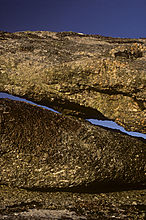|
|
|
|
Leskernick HillPropped stone
|
||||||||||||||||||||||||
|
|
|
Images (click to view fullsize) |
|
















|
Fieldnotes |
|
| The most northerly of the interesting features on the hill, the summit cairn is a jumbled assortment of rocks with one stone standing proud. |
31st March 2008ce Edited 11th March 2014ce |
|
Is it or isn't it? On a hillside littered with stones we have to take the experts view and say it is. The "quoit" is to be found on the upper west part of Leskernick Hill, slightly away from the main settlement remains. Although Leskernick is a bit of a hike to get to it is worth it, space, peace and just so much history. |
8th August 2004ce |
Miscellaneous |
|
|
I first saw the quoit mentioned in the Cornwall Archaeological Unit’s Review of 1995-6, which had an article called ‘Leskernick Summer Solstice Alignment’ that reported “an arrangement of stones, at first sight a natural feature, on a small tor over looking the moorland River Fowey and with beautiful views across to brown Willy and Roughtor, was on closer inspection shown to be a created feature. It was first recognised by Peter Herring and Tony Blackman on a field trip in April 1995. On the same field trip a long mound was found nearly a kilometre away on Beacon Hill (SX19037955). Both features had an early prehistoric feel, one like a ‘quoit’, the other like a long cairn. It was suddenly noticed that the long mound’s axis pointed towards the quoit which was now a skyline feature on Leskernick Hill. Furthermore the alignment was noted by Chris Riding to be at roughly 315o, close to the summer solstice sunset. A group of people consequently gathered at the long mound on the 21st June when the sky was fortunately clear and saw the sun set just to the east of the quoit. At first disappointed, the group then realised that the error might be chronologically significant, in that the world’s wobbling may have been its cause. The two sites were then accurately mapped (to within a few centimetres) using an Electronic Distance Meter…. Their results were passed to Bernard Yallop, Superintendent of her Majesty’s Nautical Almanac Office who was able to calculate when the two sites would have been aligned with the summer solstice sunset. He offered three dates, depending on whether people were viewing the top, middle or bottom of the setting sun, of 1400 BC, 3687 BC or 7627 BC respectively. Clearly the middle of the sun, 3687 BC, or Early Neolithic, fits most neatly with the shapes of the monuments. It was clear that other prehistoric features were set up in relation to both the alignment (a stone circle and a barrow are on the line, between the long mound and the quoit) and the quoit (a fine hut settlement in dense clitter on Leskernick’s western slopes appears to refer to the quoit which is the dominant skyline feature above it). A team from University College, London is currently carrying out research on and around Leskernick, examining how prehistoric people perceived and reacted to the natural and created landscape. Led by Chris Tilley, Barbara Bender and Sue Hamilton, it promises to add considerably to our knowledge and thinking about this important landscape. The newly discovered quoit and long mound and their significant alignment demonstrate that much of significance awaits discovery” If you fancy buying a copy of the Cornwall Archaeological Unit’s Review of 1995-6, called ‘Archaeology Alive No 4’, check out the CAU’s website, which I added a while ago on the ‘Links’ page. It is currently being flogged off cheap at £1. |
 Posted by pure joy
Posted by pure joy27th April 2003ce Edited 27th April 2003ce |
Links |
|
Google Books'The Propped Stone', which is a much better description for these stones. Taken from 'Stone Worlds' book by Barbara Bender, Sue Hamilton and Chris Tilley. |
 Posted by moss
Posted by moss11th March 2014ce Edited 12th March 2014ce |

